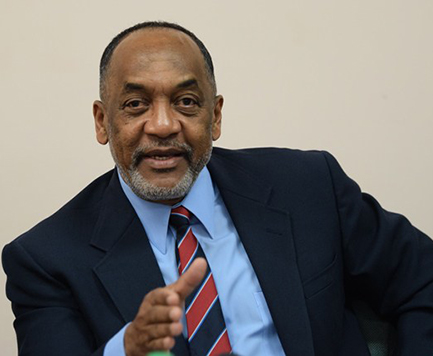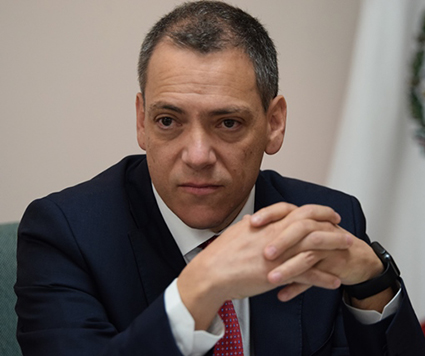Key stakeholders in Guy-ana’s nascent oil and gas sector are taking part in a capacity-building workshop aimed at improving industrial safety and environmental regulation.
The three-day workshop is a collaboration between the Embassy of Mexico, in Georgetown, and the Government of Guyana.
At the launch at the Mexican Embassy on Brickdam yesterday, Mex-ico’s Ambassador to Guyana Ivan Sierra said that he could not be happier at being able to make a contribution to the implementation of Guyana’s Green State Development Strategy.

Mexico’s Agency for Safety, Energy and Environment (ASEA) is facilitating the workshop, under the theme ‘Lessons Learned and Regulatory insights for Guyana’s Extractive Industries.’
The general aim of the workshop is to provide participants with an initial overview of empirical findings regarding industrial safety and environmental regulation of the oil and gas industry based on the Risk Management Model that was developed by ASEA, which is also the main regulatory body of the Mexican oil industry.
Some three dozen participants from the Ministry of the Presidency, the Ministry of Natural Resources, the Environ-mental Protection Agency (EPA), the Department of Environment, the Department of Energy (DoE), the Guyana Geol-ogy and Mines Commis-sion (GGMC), the Guyana Lands and Surveys Com-mission (GL&SC), the Maritime Administration Department (MARAD), and the Guyana Oil Com-pany (GuyOil) are taking part.
In brief remarks at the opening yesterday, Execu-tive Director of ASEA Carlos De Regules, who is overseeing the workshop, said he felt privileged to be able to witness, first-hand, how Guyana is preparing for the oil and gas industry.
“It is a personal satisfaction for me being able to be here with you and feeling a little bit of the same feeling we had four years ago when we were launching (ASEA) in Mexico,” de Regules said. He pointed out that even though his country has been involved in the oil and gas sector for several decades, the recent shift in the energy model more than four years ago resulted in them having to transition into a new market.
“We were moving from a monopoly-driven oil and gas production system to a market system and so institutions needed to be created, regulations needed to be put in place that would ensure that the new oil and gas development would be responsible under precautionary regulations for safety of people and the protection of the environment,” he explained.
Even though ASEA was only created in 2014, the agency currently has a working team of more than 450 persons and oversees 300 oil platforms in the Gulf of Mexico, six refineries, 60,000 km of pipelines and other infrastructure.
“Our lesson is that regulatory certainty is a good deal for the industry. We have been working very closely with different stakeholders to produce these regulations (and) have worked closely with international partners in the United Kingdom, in Norway, very specifically in the United States (of America) and Canada, and bringing those best practices from across the world to Mexico has given the market the certainty that the rules are known, predictable and therefore, they can incorporate these precautionary rules into their business plan,” de Regules added.
Meanwhile, New Ex-ecutive Director of the EPA Dr Vincent Adams, in brief remarks, underscored the importance of environmental health and safety.
“One thing I’ve learnt is that the environmental business, and health and safety business is not as sexy as the oil production itself. It’s always a challenge to prove to people your worth. You can’t touch and feel and even ensure the importance of environmental health and safety until something goes wrong, really bad. Then everyone remembers there is an EPA. But those are the challenges,” Adams said. He highlighted that often when there is a catastrophe in the sector, it is mainly the result of a small mistake.
Head of the DoE Dr Mark Bynoe said the course should not only focus on the good lessons but the bad ones too, since those are often the ones that stay with people the longest.
“We can also share that so Guyana will know what to avoid. This collaboration is important not just externally but internally and I am happy to be sitting next to Dr Adams as clearly, in the area of contractor administration, our department will need to be working very closely with the EPA to ensure that in the final analysis, we reduce any potential negative externalities associated with the oil and gas sector,” he said. He emphasised that his department stands ready to continue the collaboration going forward.
Minister of Natural Resources Raphael Trotman was also present and officially opened the session.
On the first day, the workshop will cover Mexico’s experience in the oil industry, ASEA’s legal framework and technical know-how, ASEA’s risk management method, ASEA’s funding and talent development mechanisms, the regulatory framework for upstream activities, and specific standards and protocols to regulate oilfield exploitation and prevent accidents.
The second day will focus on regulation of upstream activities, environmental baseline, environmental impact assessment, risk-based inspection strategy for offshore infrastructure, ASEA’s approach to foster monitoring and enforcement capacities by outsourcing specific tasks, international best practices for training and certification of inspectors, emergency preparedness and rapid response, and scenarios in oil and gas regulation.
The final day will see a working session with staff from the EPA on the roadmap towards building a modern and efficient regulator in Guyana and will focus on capacity building, legal framework, and funding and talent development.






